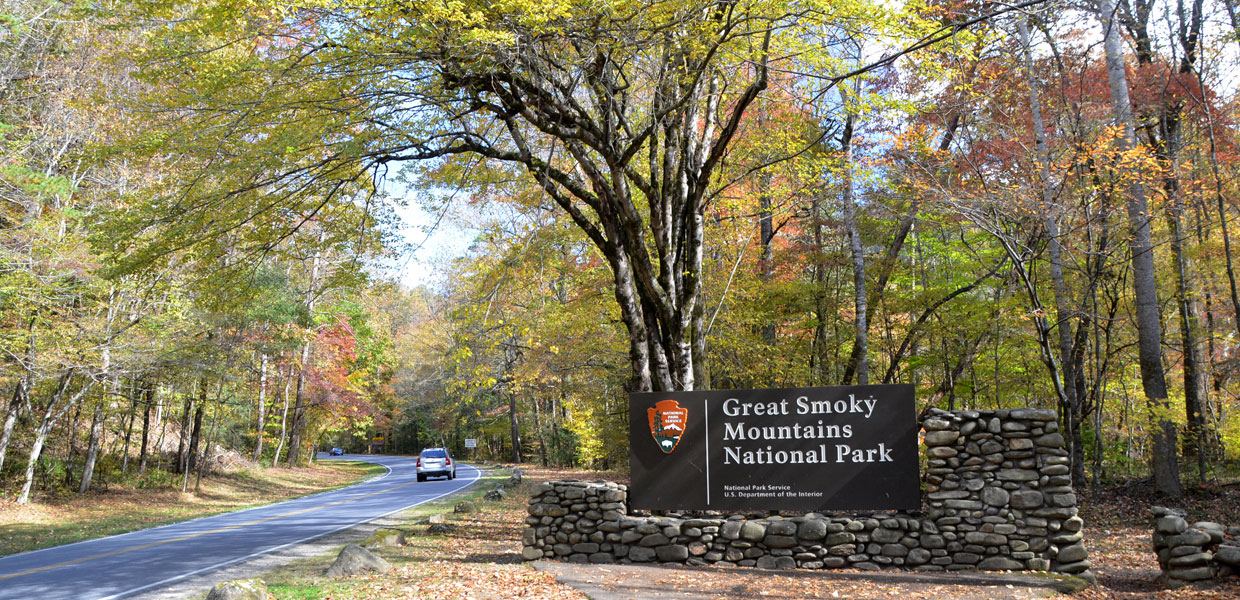THE SMOKIES
The Folkestone is a great home base for exploring the National Park
Information and Visitor Centers
The 1908 historic courthouse in downtown Bryson City is one of four GSMNP Information Centers in communities outside the Park. Friendly staff is ready to assist you with directions, maps, brochures and helpful tips about visiting the area. There is a $5/day fee for parking in the National Park, with multi-day options. Passes are available at the Visitor Center or at kiosks in the Park.
Located on US 441 two miles north of Cherokee at the Park entrance, the Oconaluftee Visitor Center is the Park's main welcome and information center for the North Carolina side. The center is staffed daily (except Christmas) by knowledgeable, helpful park rangers and volunteers. A museum recounts the history of life in the Smokies from native Americans and early European settlement time periods through the creation of the National Park.
The Road to Nowhere
Just a few miles outside of town, The Road to Nowhere is a scenic mountain highway that takes you six miles into the Great Smoky Mountains National Park and ends at the mouth of a tunnel. On the map, it is called Lakeview Drive, but to the citizens of Swain County, it is “The Road to Nowhere — A Broken Promise.” This remnant of a road never completed through the Park provides beautiful mountain views and an overlook of Fontana Lake. Walking through the quarter-mile-long tunnel takes you to hiking trails and fishing holes.
Mountain Farm Museum
In a field behind the Oconaluftee Visitors Center and along the Oconaluftee River, the Park Service has recreated a late 19th century mountain farm with authentic log structures moved from their original locations throughout the National Park. One of the buildings, the John E. Davis farmhouse, originally stood in the Indian Creek/Thomas Divide area north of Bryson City.
On some days, most often in the late afternoon, elk can be observed in the field adjacent to the Mountain Farm Museum.
Mingus Mill
A large water-powered mill for grinding corn can be seen in operation one-half mile north of the Oconaluftee Visitors Center in Cherokee on US 441. The grounds are open daily.
Built in 1886, this historic grist mill uses a water-powered turbine instead of a water wheel to power all of the machinery in the building.
A miller is on site to demonstrate the grinding of corn into cornmeal, which is available for purchase. Miller's hours: 9:00 am - 5:00 pm daily mid-March through mid-November. Also, open Thanksgiving weekend.
Newfound Gap and Kuwohi
A visit to the Great Smoky Mountains National Park is not complete without a drive to the park's highest elevations, at Newfound Gap and Clingmans Dome. Just north of Mingus Mill you might see elk next to the road in the late afternoon.
The Newfound Gap overlook is on US 441 at the North Carolina – Tennessee state line. At 5,046 feet, the gap is the lowest drivable pass across the mountains – 3,000 above Bryson City and Cherokee. The drive from Cherokee is roughly 18 miles.
At 6,644 feet, Kuwohi (formerly Clingmans Dome) is the highest peak in the Smokies and the third highest east of the Mississippi. From the parking lot, seven miles west of Newfound Gap, walk the steep half-mile path to the 54-foot observation tower for a 360-degree view of the Park. Sunrises and sunsets are spectacular. The Appalachian Trail crosses Kuwohi, marking the highest point along its 2,144-mile journey. The road to Kuwohi is closed from December 1 until April 1.
Day Trips in the Park
The Great Smoky Mountains National Park's half-million acres are equally divided between Tennessee and North Carolina, requiring at least a full day to take it all in.
Cataloochee Valley, on the eastern end of the North Carolina side near Waynesville, was one of the largest and most prosperous settlements in what is now the National Park. Some 1,200 people lived in this mountain valley in 1910. It is the best place in the park to see historic frame buildings from the late 19th and early 20th centuries. It's also one of the Park's best places for elk watching.
Cades Cove, on the western end of the Tennessee side, is a wide valley surrounded by mountains and one of the most popular destinations in the Great Smokies. It offers some of the best opportunities for wildlife viewing in the park. Large numbers of white-tailed deer are frequently seen, and sightings of black bear, coyote, ground hog, turkey, raccoon, skunk, and other animals are also possible.






